Market
Why the Pandemic Will Actually Strengthen the Art Experience Economy—and the Old-Fashioned Gallery Business, Too
The post-thing economy—starting with Superblue—could save the art market from obsolescence.
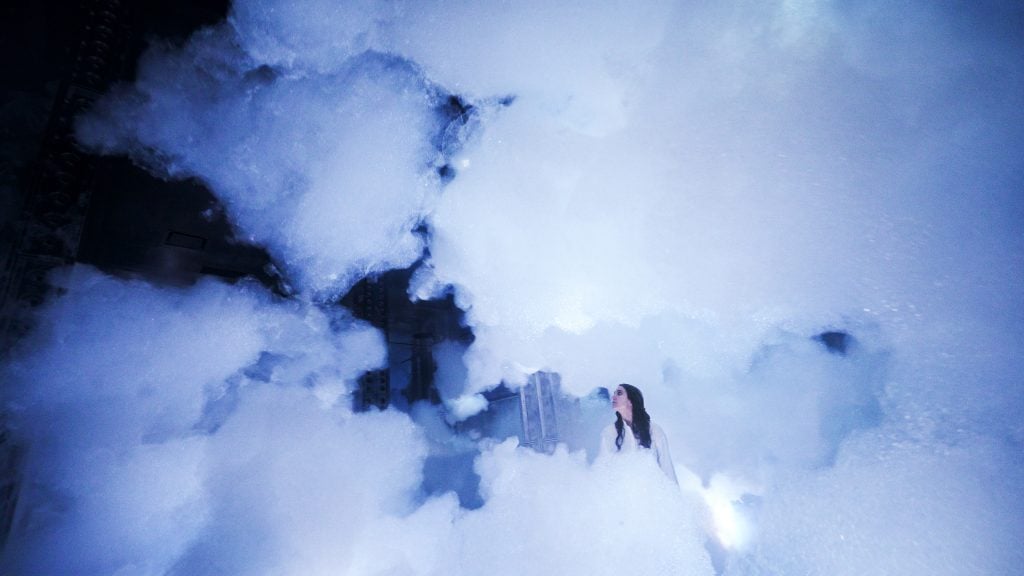
The post-thing economy—starting with Superblue—could save the art market from obsolescence.

Tim Schneider

A version of this story first appeared in the spring 2021 Artnet Intelligence Report, which you can download in full for free here.
The launch of Superblue could not have come at a worse time.
It was August 2020, in the heat of the summer lockdown, when the company announced its formation to a largely skeptical art world. It would pursue, it said, a twin mandate: to produce show-stopping immersive artworks for mass audiences of ticket buyers at a 50,000-square-foot “experiential art center” in Miami and take on experiential commissions for private and public clients at an ever-evolving array of off-site locations around the world. Both goals would be achieved in collaboration with A-list artists bridging the increasingly hazy borders between creative disciplines.
The much-hyped inaugural program would include a mirrored labyrinth by the Olivier Award-winning scenic artist and set designer Es Devlin, a past collaborator with Billie Eilish and Beyoncé; 360-degree interactive software environments by art collective teamLab; and an enveloping “Ganzfeld” light installation by James Turrell, whose roughly 60-year career awing the public with perceptual wonders has guided the vision of Superblue.
In other words, it had a very specific cocktail in mind. Big art. Big names. Big… crowds.
Some would have questioned Superblue’s mission regardless of the events of 2020.
What was the art world supposed to make of this company, which boasted investment from Laurene Powell Jobs and seemed to hybridize a cultural-events producer, a major gallery, and a gilt-edge selfie factory? Was it a competitor to traditional art dealerships, looking to poach their artists and turn their nuanced works into blockbuster entertainment? Or was it a thoughtful, fearless effort to expand art’s audience beyond the elite clique it’s catered to for more than 100 years?
With life as a whole upended by a global pandemic, however, those questions were largely swept aside by an existential quandary: Could Superblue, and the experiential art economy it envisioned, survive the coronavirus?
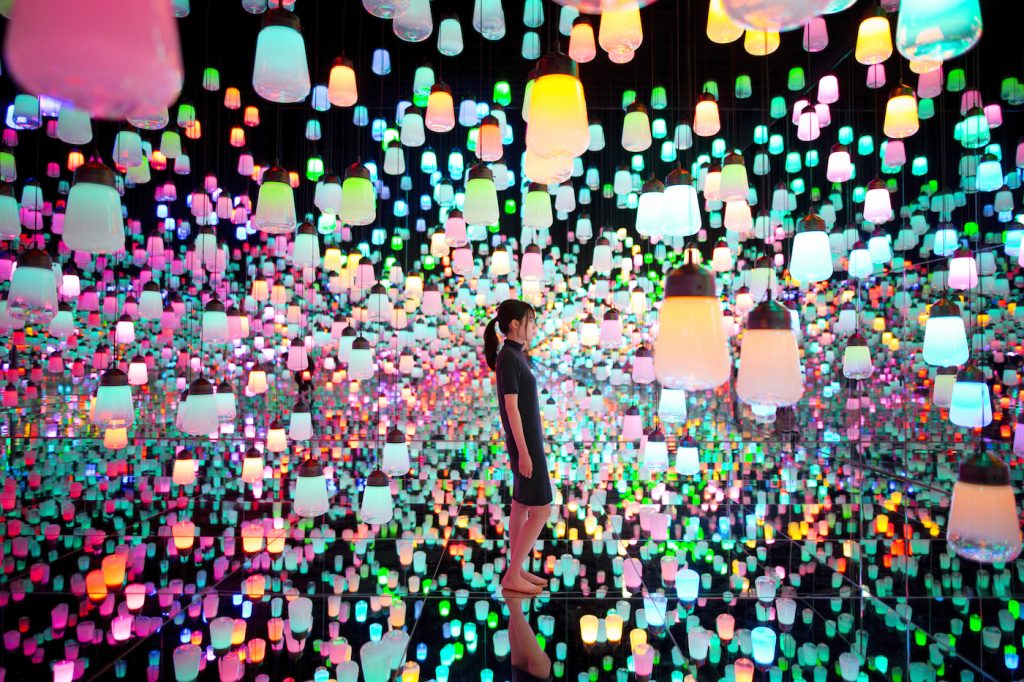
teamLab, Forest of Resonating Lamps-One Stroke, Metropolis (2018). Installation at Mori Building Digital Art Museum, teamLab “Borderless.” Courtesy of teamLab and Pace Gallery.
Despite what appeared to be colossally bad timing, Superblue forged ahead. Its Miami complex, originally scheduled to launch in December 2020 in the up-and-coming Allapattah district, is now due to debut on April 22. The company plans to hire 60 staff members there to complement its existing team of nearly 40 split among New York, London, and Miami.
Superblue’s leaders are wagering that, rather than doom the experience economy, the COVID clampdown actually strengthened it. Even more surprisingly, the biggest beneficiary of Superblue’s radical focus on charging admission just might be the traditional art market.
Superblue is the next logical destination on a path art and culture have been traveling for generations. By the dawn of the 21st century, the world’s most prominent art institutions had spent three decades following the map drawn by “Treasures of Tutankhamun,” the record-breaking exhibition of Egyptian artifacts that inaugurated the museum-blockbuster model with its U.S. tour culminating at the Metropolitan Museum of Art in 1978—just as the same maximalist, populist mode began dominating Hollywood.
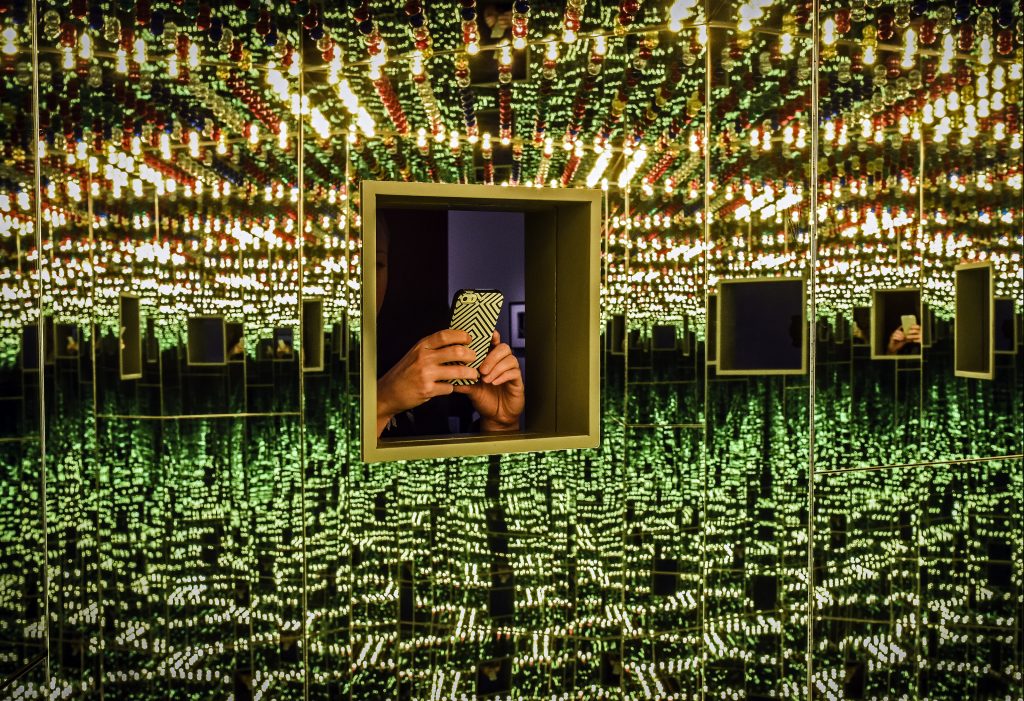
Installation view of “Infinity Mirrored Room-Love Forever” at the Hirshhorn. (Photo by Bill O’Leary/The Washington Post via Getty Images)
By the early 2010s, smartphones and social media had led many to devote a good portion of their recreational lives to capturing and broadcasting their immersion in striking settings. This preoccupation made overnight global sensations of canonical artworks like Yayoi Kusama’s “Infinity Mirrored Rooms,” made-for-Instagram playgrounds like the Museum of Ice Cream, and a new breed of artist-created participatory environments like teamLab Borderless, the art/tech collective’s museums in Tokyo and Shanghai.
Not everyone has greeted the shift kindly. “I want to be challenged, I want to be uncomfortable, I want to be provoked,” critic Kriston Capps said in a 2018 interview about the Indianapolis Museum of Art’s transformation into the mainstream-courting mashup rebranded as Newfields: a Place for Nature and the Arts. “And when those possibilities are not even on the table, well, then it’s not art. It’s more like a food court or an amusement park.”
But disruption-hunting Superblue cofounder and board chair Marc Glimcher isn’t particularly interested in how Capps might define art. If “regular people” pay to see an installation, as Glimcher sees it, the art establishment inevitably dismisses the work as “just a spectacle”—code signifying that it’s “not good” or, indeed, even “art” at all.
At Superblue, he said, “we don’t think that’s a very 2021 point of view.”
The smearing of boundaries between fine art and other disciplines is necessary for Superblue’s success. For its installations to attract the maximum number of visitors, some of them must appeal to audiences interested in the arts, plural: fashion, theater, design, live music, dance, and more. For Glimcher, that’s the future.
“These artists, like so many greats throughout history, are trying to do something that will change the way you think about everything,” he said. “We’re going to all this trouble and expense because what these people are offering could be one of the biggest impacts on human consciousness since movies or phones.”
Glimcher’s borderline-messianic belief in the value of interdisciplinary experiential art collided with a math problem that has been vexing the commercial gallery sector for decades: If the artists you want to work with are primarily interested in creating shared experiences rather than salable objects, can you sustainably fund the former without diverting their valuable time and resources to the latter?
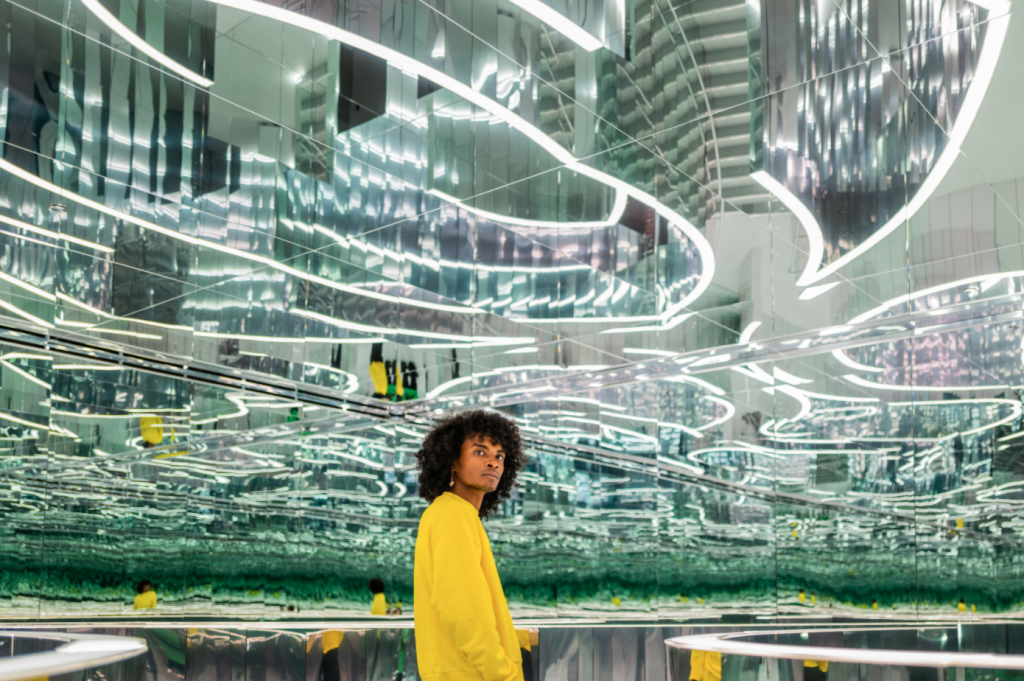
Es Devlin, Forest of Us (2021). Installation view of Every Wall is a Door, Superblue Miami, 2021. Photo: Andrea Mora.
Glimcher was intimately acquainted with dealers’ usual answer, thanks to his day job as president and CEO of Pace Gallery, the international art juggernaut where his father, Arne, began collaborating with Turrell, Robert Irwin, and other experiential-art innovators shortly after its founding in 1960. (Superblue and Pace insist they are independent businesses, despite crossover in their executive ranks and artist lists and the fact that Superblue’s New York team worked out of Pace’s former Upper East Side gallery before going fully remote in March 2020.) Producing such installations meant Pace had to “beg, borrow, and steal” to fundraise the budget, Glimcher explained, then try to sell enough “souvenirs” to get out of the red.
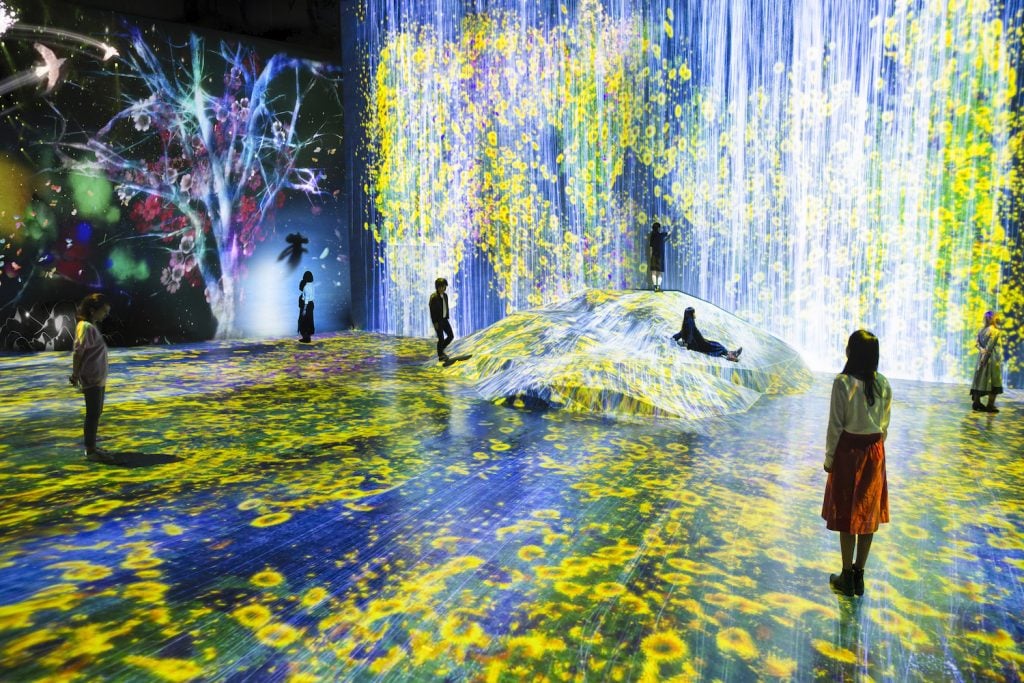
teamLab, Universe of Water Particles on a Rock where People Gather (2018). Installation at Mori Building Digital Art Museum, teamLab “Borderless.” Courtesy of teamLab and Pace Gallery.
Granted, the souvenirs he referred to aren’t coffee mugs or T-shirts; they are unique or limited-edition artworks, often priced at tens or hundreds of thousands of dollars each. But if a gallery is trying to produce an experiential work of the magnitude of, say, Roden Crater, the volcanic cinder cone that Turrell has spent more than 40 years transforming into a network of meticulously crafted architectural installations, it needs to sell a lot of Turrell’s domestically friendly interior LED installations to cover the costs.
Superblue’s ticketing model changes the equation. It is largely modeled on teamLab, whose museum in Tokyo drew 2.3 million paying visitors in its first year of operation. (For comparison, the Van Gogh Museum, in Amsterdam, attracted 1.4 million that same year.)
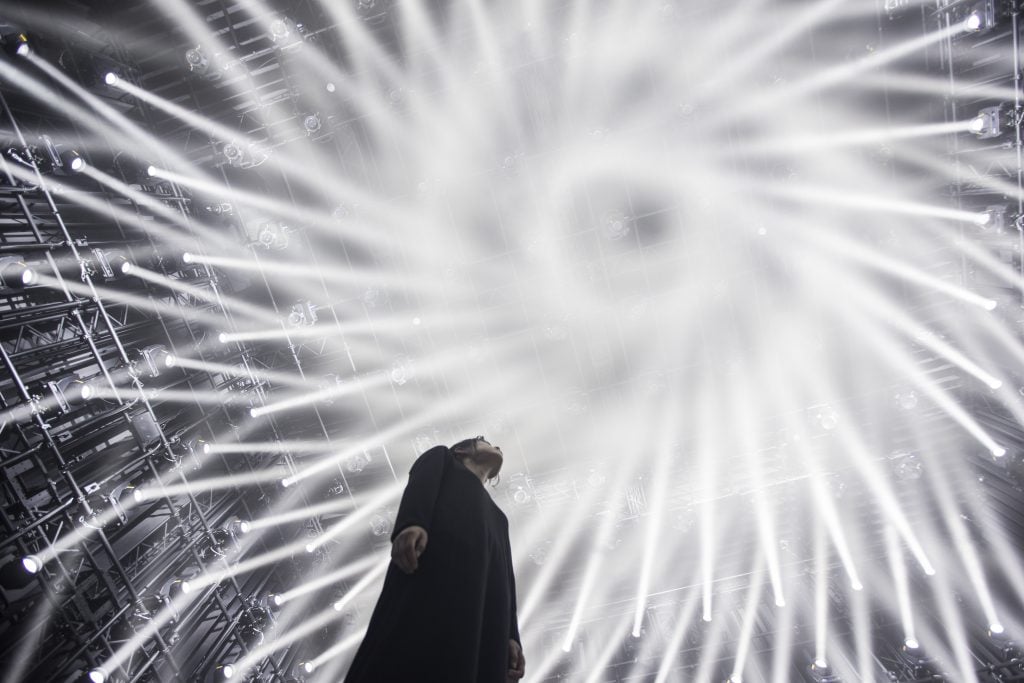
teamLab, The Haze (2018). Installation at Mori Building Digital Art Museum, teamLab “Borderless.” Courtesy of teamLab and Pace Gallery.
Superblue pays each artist an upfront fee to create an immersive work, as well as a royalty from gross ticket sales throughout its run. (The size of the fee and royalty vary on a case-by-case basis.)
Since every Superblue artist receives funding directly from the general public, the relationship becomes more lucrative the more popular an installation is—just as in mass-culture businesses like Hollywood, pop music, and book publishing. As Mollie Dent-Brocklehurst, Superblue’s cofounder and CEO, puts it, “You couldn’t sell a single visit to a rich collector” and expect the model to function; it only succeeds at scale.
With admission to the inaugural trio of Miami installations starting at $30, scale seems plausible. Yes, it’s slightly higher than full-price admission to the Museum of Modern Art ($25). But it’s also $9 less than a ticket to, say, the Museum of Ice Cream’s New York flagship.
It’s not only the art in Superblue’s universe that departs from tradition—the artists do, too. These aren’t, by and large, lone geniuses working in their studios with an assistant or two. Some are full-fledged companies that have grown as immersive art experiences have exploded in popularity.
Take teamLab, whose LinkedIn profile lists “artists, programmers, engineers, CG animators, mathematicians, and architects” as part of a team that exceeds 500 employees. (That the collective has a LinkedIn profile underlines the contrast with the old school.)
“When we started looking at the program, it seemed to me that the artists making the most interesting experiences tended to be collectives,” explained Dent-Brocklehurst. “To create the high-tech element and monumentality of these shows, it took a lot to put it all together.”
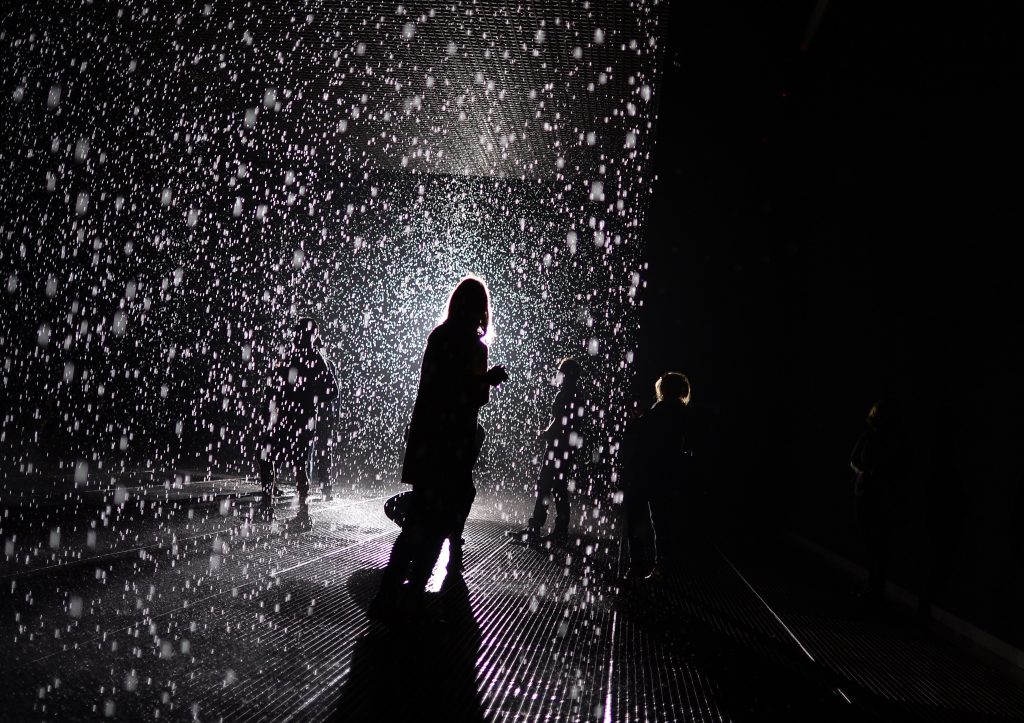
A visitor at Random International’s Rain Room at MoMA (2012). Photo: TIMOTHY CLARY/AFP via Getty Images.
Another collective working with Superblue, Random International, shot to international acclaim in 2012 with Rain Room, an environmental installation that enables visitors to waltz through an artificially generated monsoon without getting wet, thanks to a halo of dry space that follows them as they move. After its London debut, the installation went on the road, drawing tens of thousands of visitors to high-profile institutions like MoMA, in New York; the Yuz Museum, in Shanghai; and the Los Angeles County Museum of Art.
Random International cofounder Hannes Koch described Rain Room as “more of a logistical challenge than a creative one” after a certain point. The studio had to allocate tremendous resources to solving the technical and bureaucratic issues that arose with each new site. Koch said he and fellow cofounder Florian Ortkrass soon realized “there wasn’t a sustainable model” that would enable them to keep creating public artworks of a similar scale and complexity.
For one thing, you need someone—not an artist, but a producer of sorts—to twist arms and get things done, Koch explained: “If you’re hellbent on bringing the way you feel about the world into an experience or public object, you need a lot of backing, a lot of technical and infrastructural firepower to convince people. You have to feed the monkey in some sense, and that’s not what we’re here for.”
Random International peaked at 30 full-time employees in early 2019. Two years later, it is about half that size, with staff members including software and architectural designers, a senior commissioning manager, and even a dramaturge to help craft the narrative and tease out the art historical lineage of each new project.
Superblue has been an important part of this “rightsizing” process, Koch said, noting that Random International now focuses the majority of its in-house energy on “broad experimentation, research, initial prototyping,” and the final stages of each project; intermediate steps are largely handled by a mix of studio staff and external partners, including Superblue.
This structure leaves the studio free to “pursue weird hunches relentlessly,” then call up institutionalized resources on demand rather than agonizing over every detail.
Beyond solving a problem for ambitious artists, the true innovation of offerings like Superblue, some observers said, is that it imports to the art market models that the broader retail industry has profitably used for years.
Resonant in-person experiences—even when they cost visitors nothing—have proved hugely effective at driving traditional sales. Futurist, author, and retail consultant Doug Stephens framed the phenomenon through Apple’s “profound” decision to transform its physical stores into aspirational, high-design temples to product exploration and customer service.
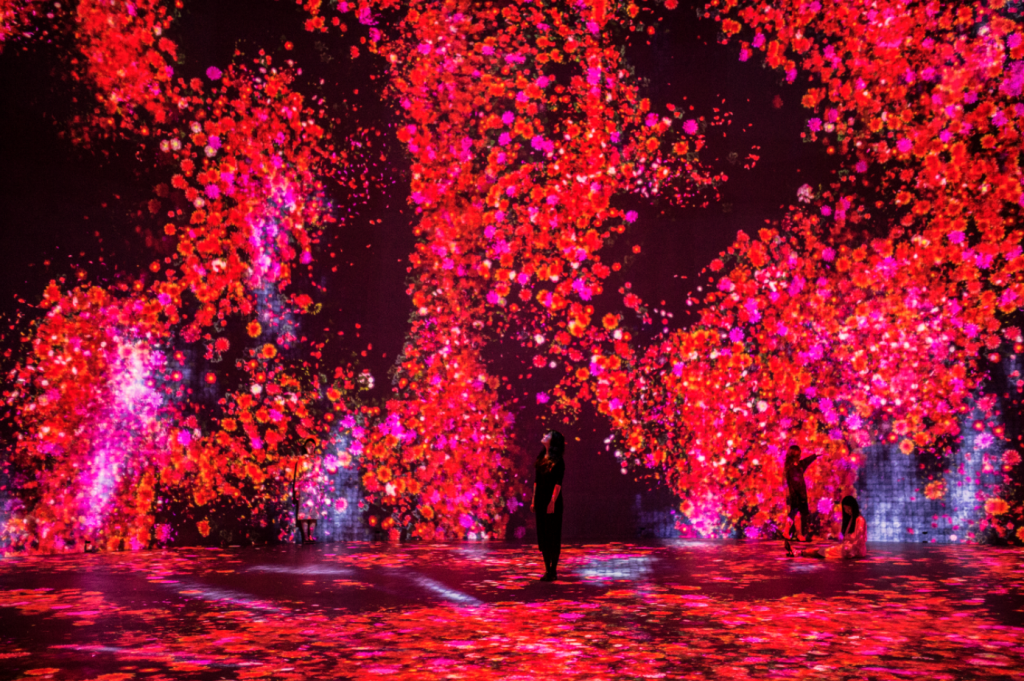
teamLab, Flowers and People, Cannot be Controlled but Live Together – Transcending Boundaries, A Whole Year per Hour (2017), Interactive Digital Installation, Sound: Hideaki Takahashi. © teamLab, courtesy Pace Gallery.
“What Apple recognized decades before everyone else was that e-commerce doesn’t negate the value of stores,” he explained. “Stores became experiential playgrounds aimed not so much at sales but at customer acquisition. If we can draw people to touch and play and kinetically experience the products, it draws them into the ecosystem and gives us a customer for life that we can service in all kinds of ways.”
Superblue’s immersive installations could have the same effect on visitors of means who aren’t yet collectors. Since the company works with multiple artists represented by galleries other than Pace, as well as some who have no dealer at all, Superblue could hook visitors in a quasi-institutional setting, then send them off to become clients elsewhere in the art-market ecosystem.
(Dealers may still require some convincing on this point. Asked how Superblue might impact the existing gallery system or whether they could envision collaborating with the company, five major gallerists declined to comment.)
In this model, as Koch sees it, artists benefit from “an integrated landscape where we can show the work wherever it’s most relevant,” and everyone would make money doing what they do best. Proof of the virtuous cycle, he hopes, will arrive this spring when Superblue and BMW i, BMW’s electric vehicle arm, copresent a live rendition of Random International’s No One Is an Island at a to-be-determined U.S. venue.
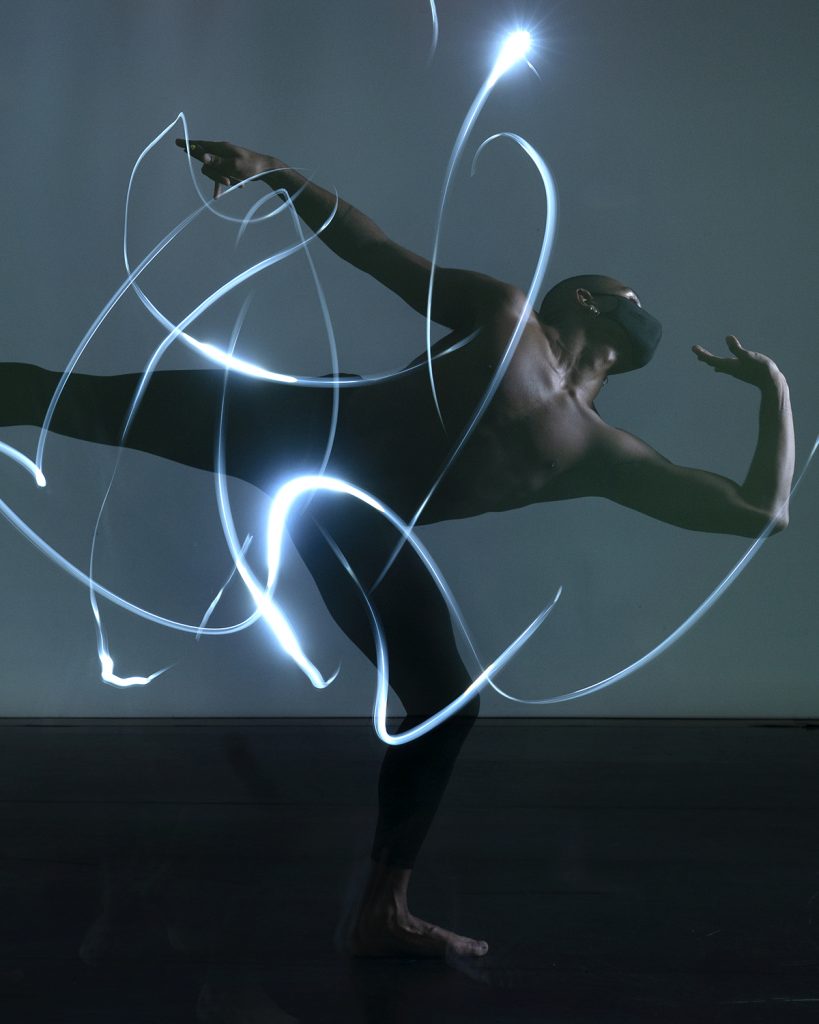
No One is an Island presented by Random International, Superblue, Studio Wayne McGregor and BMW i; dancer: Jacob O’Connell (Company Wayne McGregor). Photo: Ravi Deepres. © BMW AG
Debuted as an online-only presentation last November, the work centers on a software-driven robotic installation that waves its light-tipped arms to create ghostly, ephemeral images of different life forms. (Imagine an automated assembly line reprogrammed to produce flashlight “drawings” in homage to Eadweard Muybridge.)
In-person viewers will soon see this piece complemented by live choreography and a commissioned score to further explore our evolving relationship to our environment as software and automation increasingly replace nature and human interaction. The installation itself grew out of Fifteen Points/I (2016), a smaller, simpler forebear included in Random International’s solo show at Pace New York a half decade ago.
“Domestic objects, editions, and series we’ve often seen as prototypical studies,” Koch explained. “The long game plan is to bring what we do into the public context.”
No One Is an Island is on schedule to be the first project realized by the less-discussed arm of Superblue’s business, which facilitates commissions and collaborations with outside parties such as museums, cities, arts festivals, and corporations. The way this is monetized depends on the project: It could be an admission fee, the acquisition of the work for long-term installation, or another solution entirely. (The live presentation of No One Is an Island will not be a ticketed affair, but instead funded by BMW i and Superblue.)
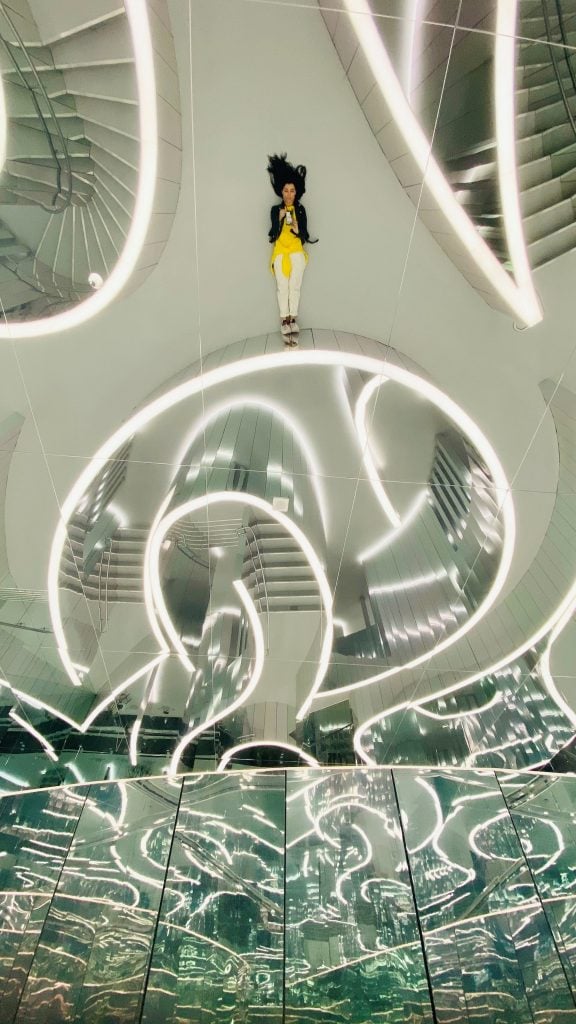
Es Devlin, Forest of Us, (2021). Installation view of Every Wall is a Door, Courtesy Es Devlin Studio. Photo credit Es Devlin.
If all goes as planned, Superblue’s experiential art center will support the ticketed side of the company’s portfolio while this other side organizes projects for hire. Admission revenue from the Miami complex can keep the coffers full while long-term, modestly remunerative commissions grind toward completion.
On paper, these shared resources make major commissions viable for Superblue when they are not for most galleries and artists. Object sales generate a more sporadic revenue stream (and thus a less reliable subsidy) than ticket sales, and Superblue has the production and operational expertise to complete projects more suited to a specialty architecture firm than a traditional art dealer.
“Galleries are where public commissions go to die,” Glimcher said. “It’s not because dealers aren’t excited. It’s because it requires a different skill set to deal with municipalities, real-estate committees, community boards, contractors, engineers.”
By fusing in-house ticketed experiences with outside commissions, Superblue’s infrastructure enables each side of the business model to support the other for the long run.
Still, what will make or break all of Superblue’s ideas are its investors. The Emerson Collective, the organization launched by Laurene Powell Jobs, receives billing as the company’s founding partner. (She declined to be interviewed for this story.) Another backer is Therme Group, a Viennese company specializing in “wellbeing resorts.” The rest remain anonymous, but Glimcher relayed that none are strictly “money investors” seeking profit. They include leaders in real estate, ticketed events, city planning, health, and other fields who can contribute knowledge Superblue lacks even at the top of its org chart.
Their investment pays for much more than just artists’ fees. Superblue leases the building housing its Miami art center from the Rubell family (whose luxe museum stands directly across the street), meaning rent on its 50,000 square feet is an ongoing expense. (Superblue declined to disclose rent or renovation costs.) The company also pays expenses throughout the life cycle of each artwork, including for equipment, production, shipping, marketing, staffing, maintenance, and de-installation.
Superblue’s profit picture hinges on what it receives in exchange. The artist and the company co-own the physical components of each installation, and the artist retains sole ownership of the intellectual property. However, in addition to all ticket revenue after the artist’s royalty, Superblue also retains the right to lease each installation to another venue (with the artist’s approval) at the end of its run in Miami.
Crucially, these non-Superblue venues could be operated by any of the wide-ranging parties the company partners with, from individual collectors to architects to municipalities. (In these cases, the artist would still be paid a royalty on gross ticket sales during the work’s run at the new location, and the host’s costs and benefits would vary based on the specifics of the project.)
The prospect of touring suggests a surprisingly apt reference point for Superblue’s ticketed experiences: the high-stakes business of Broadway.
Mitch Weiss, a manager and consultant whose career on Broadway began in 1985, compared analyzing Superblue’s strategy to “talking to a 28-year-old… who has great ideals and ideas that sound phenomenal, but real-world experience may inevitably teach them it doesn’t work as expected.”
Weiss sees the two businesses linked by the same core tension: After paying high front-end costs, will the ticket revenue come in fast enough to keep the show open—and long enough to make it a hit? Superblue declined to provide information about its budgets for the opening round of programming at its Miami center, so it is impossible to judge how steep a climb it faces to profitability. Still, the Broadway comparison at least offers a sense of the commercial dynamics at play.
Like Superblue in its ticketed experiences, Broadway producers must pay up front to rent a venue, outfit it properly (see: stage and scenery, lighting, costumes), and secure the talent (see: writers, directors, actors). Accomplishing this feat in 2021 requires signing on a consortium of investors (usually between 20 and 35 of them).
With the investors’ seed money in hand, the producers prepare the show, market it like mad—and hold their breath to see if the audience will come.
According to Weiss, the average Broadway musical costs between $18 million and $22 million to produce today. Yet while production expenses have skyrocketed over the decades, he said, the bust rate “has stayed consistent since I was a little child.” Then and now, he estimated, 80 percent of Broadway shows flop, wiping out their investors’ contributions in the process. Hits, though, are “better than Vegas ever could be,” with backers earning annual returns of “hundreds of percent.”
These runaway successes largely come courtesy of tourists and touring—two factors Superblue hopes to benefit from. But the ongoing complications of the pandemic raise questions about both.
In a January 2021 New York Times story, Superblue COO Marcy Davis responded to a question about the effect of the pandemic by stating that the Miami art center is “not dependent upon fly-in tourism,” thanks to the large audience in South Florida and a likely “increase in day-trippers driving to Miami from throughout the region.”
Superblue’s experiences were conceived from the start around timed tickets, controlled capacity, and unidirectional traffic flow, but the company has pledged that the initial cycle of installations will open with an even lower cap on attendance, and they will remain on view through at least the end of 2022.
All of the above suggests that Superblue has vastly more cushion from its investors than the average Broadway musical. According to Weiss, a new musical will normally be forced to close within its first three months if its audience is restricted to residents of the tristate area.
If the same show becomes a tourist attraction, however, its lifespan and earnings are limitless. Weiss notes that, in the 1950s and ’60s, the tenure of a Broadway hit maxed out at roughly 18 months. Fast-forward to 2021, and Phantom of the Opera is entering its 35th consecutive year. The producers of a hit can also license the show’s subsidiary rights to theaters around the world to extend its earnings, just as Superblue can license its installations to venues elsewhere.
Will the demand be there, though?
Glimcher, for one, is confident. “Somewhere in the middle of COVID, people started thinking, ‘All those [cultural] dollars… do I really want to spend them sitting in a chair three and a half inches from another person? Or do I want to be looking in a really energized way, walking around experiences that are not jammed?’”
Glimcher relayed that additional Superblue investors are “coming out of the woodwork during COVID.” The new funding has the company planning to open two more art centers in undisclosed cities in the U.S. and internationally.
Similar immersive art experiences have also bounced back strongly from the 2020 shutdowns. Artechouse, which presents experiential exhibitions from artists melding art, science, and technology, has welcomed more than 150,000 visitors since reopening its three for-profit spaces in New York, Miami Beach, and Washington, D.C., last fall. Cofounders Sandro Kereselidze and Tati Pastukhova plan to announce locations in “at least” three new cities by the end of 2021—a feat that is all the more notable since Artechouse has been entirely self-funded since opening its first building, in 2017.
There is at least one positive indicator on the touring front, too. Carne y Arena, an immersive installation by the filmmaker Alejandro González Iñárritu meant to communicate the harrowing experience of migrants crossing the southern border of the U.S., will travel for “the next five years, at least,” according to the project’s technology and set design partner, Phi Studio.
The company, which optimized the experience for pandemic touring, sold out the final weeks of its engagement in Denver after it reopened in January 2021. Carne y Arena debuted in Montreal in mid-March, with producers in discussions with venues in the US, Europe, and Asia for later dates. (Another of the installation’s producing partners happens to be Laurene Powell Jobs’s Emerson Collective.)
Even if Superblue Miami opens to an attendance drought, the company could very well weather it. As long as its investors stay on board, short-term ruptures and inevitable tweaks to the model will be irrelevant. Which is fitting, since Superblue’s mission is ultimately to aid its artists in leading us away from the here and now.
“They’re not documenters, these artists, they’re dreaming the future,” Dent-Brocklehurst said. “It’s not a mirror. It’s a window.”
This story originally appeared in the Spring 2021 Artnet Intelligence Report. To download the full report, which includes in-depth data analysis of auction performance in 2020, a profile of the best bad painter out there, Robert Nava, and a look inside the forgery scandal that rocked the art world, click here.